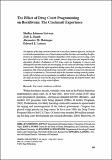| dc.contributor.author |
Shelley Johnson Listwan, Jody L. Sundt, Alexander M. Holsinger and Edward J. Latessa |
| dc.coverage.spatial |
Estados Unidos |
| dc.date.accessioned |
2016-01-07T15:29:12Z |
| dc.date.available |
2016-01-07T15:29:12Z |
| dc.identifier.uri |
http://desa1.cejamericas.org:8080/handle/2015/3538 |
| dc.description.abstract |
The impetus of the drug court movement can be traced to a number of factors, such as the social and organizational costs of imprisonment and the literature surrounding the effectiveness of community-based treatment. Regardless of its origins, however, drug courts have altered the way in which court systems process drug cases and respond to drugdependent offenders. Evaluations of U.S. drug courts are beginning to emerge, and although the outcome results are encouraging, not all courts are showing a reduction in rearrest rates. Despite the rapid expansion of drug courts, their growing prevalence, and popularity, little is known about the drug court model’s ability to achieve its objectives in a variety of circumstances. This research adds to the literature on drug courts by examining the effect of drug court programming on multiple indicators of recidivism. Results of the study are mixed; however, the drug court treatment group did perform better when examining arrest for a drug-related offense. |
| dc.language.iso |
Inglés |
| dc.title |
The Effect of Drug Court Programming on Recidivism: The Cincinnati Experience |
| dc.ceja.source |
Fuente: <a href="http://www.uc.edu/content/dam/uc/ccjr/docs/articles/Effect_of_Drug_Court_Cincinnati.pdf">http://www.uc.edu/content/dam/uc/ccjr/docs/articles/Effect_of_Drug_Court_Cincinnati.pdf</a> |

